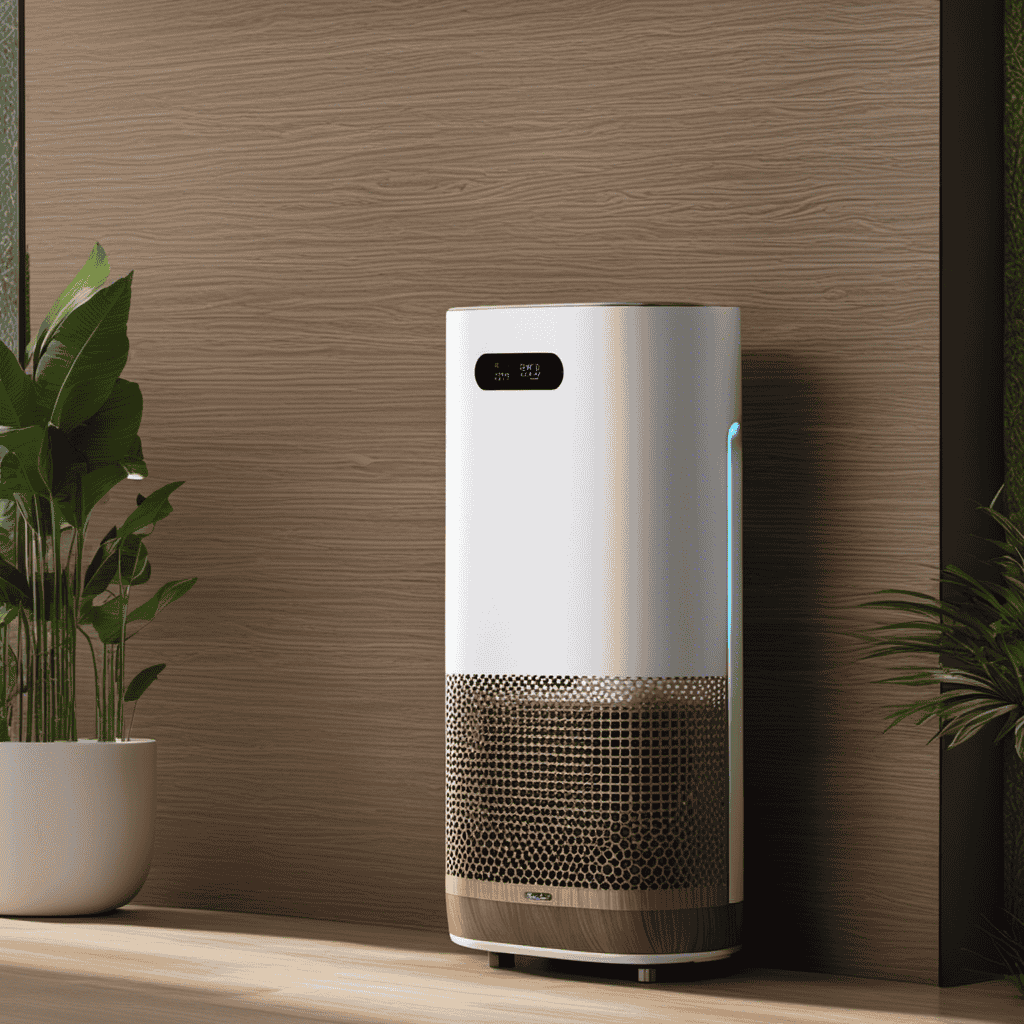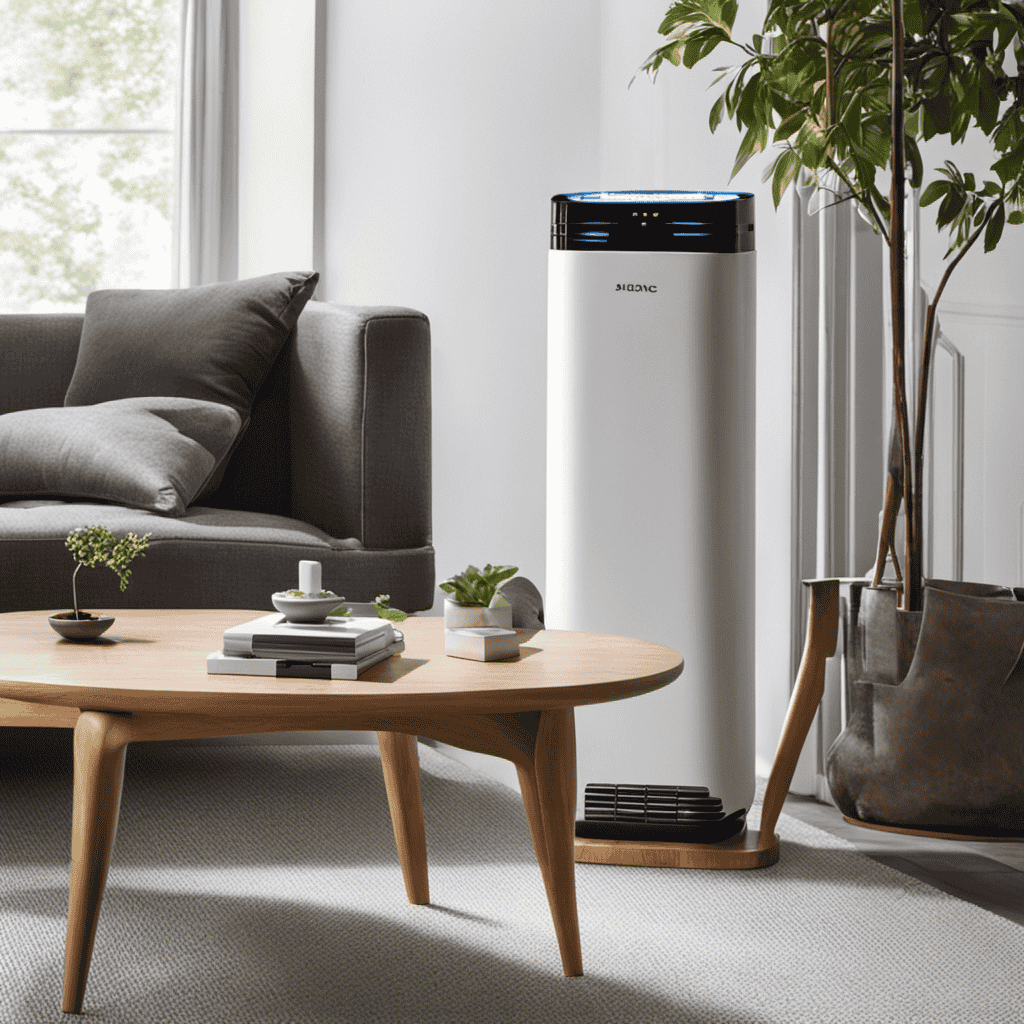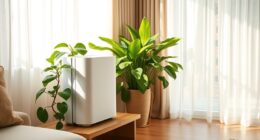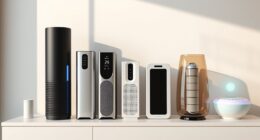I’ve been curious about the cost of air purifiers recently. After doing some research, I found out that the price of air purifiers can vary depending on different factors.
In this article, I’ll share the different types of air purifiers and their price ranges, from high-end options to budget-friendly alternatives.
We’ll also explore how to determine the right air purifier price for your needs and the hidden costs to consider.
Stay tuned for valuable tips on getting the best value for your air purifier investment.
Key Takeaways
- Factors that influence air purifier cost include brand reputation, quality, and features, as well as ongoing maintenance expenses.
- Different types of air purifiers, such as portable and whole house purifiers, have varying price ranges and suitability for different spaces.
- The price of air purifiers can range from $100 to $500 on average, with larger room purifiers and those with advanced features being more expensive.
- High-end air purifiers offer advanced filtration systems, smart technology, quiet operation, and energy efficiency, but may have higher maintenance costs.
Factors That Influence Air Purifier Cost
There are several factors that can influence how much an air purifier costs. One of the main factors is the brand of the air purifier. Different brands have different price ranges based on their reputation, quality, and features. Well-known brands like Dyson or Honeywell tend to be more expensive compared to lesser-known brands.
Another factor that can affect the cost is the maintenance expenses. Some air purifiers require frequent filter replacements, which can add up over time. It’s important to consider these ongoing costs when purchasing an air purifier.
Additionally, certain features like smart technology or advanced filtration systems can also drive up the price.
Overall, it’s essential to evaluate and compare different factors before making a decision to ensure you find the right air purifier that fits your budget and needs.
Different Types of Air Purifiers and Their Price Range
When it comes to air purifiers, there are various key purifier types available in the market. These types include HEPA filters, activated carbon filters, and ionizers.
To help you make an informed decision, it’s essential to have a price comparison guide that highlights the cost range for each purifier type. On average, the cost of air purifiers can vary from $100 to $500, depending on the features and technology they offer.
Key Purifier Types
You can choose from different key purifier types depending on your specific needs and preferences. Whether you’re looking for a portable purifier to improve the air quality in a single room or a whole house purifier to clean the air throughout your entire home, there are options available to suit your requirements. To help you make an informed decision, here is a comparison table showcasing the features and benefits of portable purifiers and whole house purifiers:
| Purifier Type | Features | Benefits |
|---|---|---|
| Portable | Compact and lightweight | Easy to move around and use in different rooms |
| Suitable for small to medium spaces | Ideal for bedrooms, offices, and small living areas | |
| Filters air in a specific area | Reduces allergens, dust, and odors in a targeted space | |
| Whole House | Installed in HVAC system | Cleans and filters air throughout the entire home |
| Covers all rooms in the house | Provides clean air in every part of your living space | |
| Requires professional installation | Offers comprehensive air purification for the whole household |
No matter which type of purifier you choose, both portable and whole house purifiers are designed to improve indoor air quality and create a healthier living environment. Consider your specific needs and preferences when selecting the right purifier for you.
Price Comparison Guide
The price comparison guide offers a breakdown of the costs for different types of air purifiers. When considering the price of an air purifier, there are several factors that affect pricing. Here are four key factors to keep in mind:
-
Brand and reputation: Well-known brands often come with a higher price tag due to their reputation and quality.
-
Filter type and lifespan: Different types of filters, such as HEPA or activated carbon, have varying costs and need to be replaced at different intervals.
-
Room size coverage: Air purifiers designed for larger rooms tend to be more expensive than those for smaller spaces.
-
Additional features: Air purifiers with advanced features like smart sensors or Wi-Fi connectivity may be pricier than basic models.
While higher-priced air purifiers may offer more advanced features, it’s important to note that even budget-friendly options can effectively improve indoor air quality. Ultimately, the choice depends on your specific needs and budget.
Average Purifier Costs
On average, it’s helpful to know the factors that influence how much an air purifier typically costs. Several factors can affect the pricing of air purifiers, including the brand, features, and the type of technology used. Popular air purifier brands like Dyson, Honeywell, and Blueair often come with a higher price tag due to their reputation and advanced technology. Additionally, air purifiers with more features such as HEPA filters, activated carbon filters, and smart capabilities tend to be more expensive. The type of technology used, such as UV-C light or ionizers, can also impact the cost. To provide a clearer picture, here is a table showcasing the average cost range for air purifiers from popular brands:
| Brand | Average Cost Range |
|---|---|
| Dyson | $300 – $700 |
| Honeywell | $100 – $400 |
| Blueair | $200 – $800 |
Keep in mind that these are just average cost ranges, and prices can vary depending on the specific model and additional features.
High-End Air Purifiers and Their Price Tags
Expensive air purifiers can come with hefty price tags, but they often offer key features that justify the higher cost. Here are four important features to consider when investing in a high-end air purifier:
-
Advanced filtration systems: These purifiers use advanced filters, such as HEPA or activated carbon, to effectively remove pollutants and allergens from the air.
-
Smart technology: High-end purifiers often come with built-in sensors and Wi-Fi connectivity, allowing you to monitor air quality and control the device remotely.
-
Quiet operation: These purifiers are designed to run silently, ensuring a peaceful environment without compromising on air purification performance.
-
Energy efficiency: Many high-end models are energy-efficient, helping you save on electricity costs in the long run.
While maintenance costs for expensive air purifiers can be higher due to the cost of replacement filters and other components, their effectiveness and additional features make them worth considering.
However, if you’re on a budget, there are also budget-friendly air purifiers available that can provide reliable air purification at a more affordable price.
Budget-Friendly Air Purifiers for Every Pocket
When it comes to air purifiers, cost-effectiveness is a key consideration.
In this discussion, we will explore affordable purification options that don’t break the bank.
Additionally, we will delve into the concept of price versus performance to help you make an informed decision on the best air purifier for your needs.
Cost-Effective Air Purifiers
If you’re looking for a cost-effective air purifier, you should consider models that offer long-lasting filters and energy-saving features. Here are some key features to look for in cost-saving air purifiers:
-
Long-lasting filters: Choose a model that uses filters with a long lifespan, as this will save you money on replacements in the long run.
-
Energy-saving features: Look for air purifiers that have energy-efficient settings, such as auto-off timers or low power modes, to help reduce your electricity bill.
-
Affordable maintenance: Consider the cost of replacing filters and other maintenance expenses when selecting an air purifier. Some models have more affordable replacement parts than others.
-
Multi-functional units: Opt for air purifiers that offer additional features, such as humidifiers or ionizers, to get more value for your money.
By considering these cost-saving options, you can find an affordable air filtration option that meets your needs without breaking the bank.
Transitioning into the next section, let’s explore some affordable purification options that are available in the market.
Affordable Purification Options
Now let’s explore some affordable purification options for those on a tight budget.
When it comes to air purifiers, there are several affordable brands available in the market that offer decent performance without breaking the bank. These brands typically offer basic features and may not have all the bells and whistles of their more expensive counterparts, but they still do a satisfactory job of purifying the air.
Additionally, if you’re feeling a bit adventurous, there are DIY options available as well. You can create your own air purifier using simple materials like a box fan and a high-efficiency particulate air (HEPA) filter. This can be a cost-effective alternative for those looking to save some money. However, it’s important to note that DIY options may not provide the same level of performance as commercially available air purifiers.
Price Vs. Performance
To get the best value for your money, consider balancing the price and performance of different purification options. When it comes to air purifiers, it’s important to compare prices and analyze the performance to make an informed decision.
Here are four key factors to consider in your price comparison and performance analysis:
-
CADR (Clean Air Delivery Rate): This measures the efficiency of an air purifier in removing particles like dust, pollen, and smoke. Look for a higher CADR rating for better performance.
-
Filter Replacement Cost: Check the cost of replacing filters regularly. Some purifiers may have expensive filters, which can add up over time.
-
Energy Efficiency: Consider the energy consumption of the air purifier. Look for models with an Energy Star certification for energy savings.
-
Noise Levels: Pay attention to the noise levels of the purifier, especially if you plan on using it in your bedroom or any other quiet space.
Cost-Effective Air Purifiers That Won’t Break the Bank
There are cost-effective air purifiers available that won’t break the bank. For small spaces, there are affordable options that can effectively clean the air.
These compact air purifiers are designed to remove allergens, dust, and pet dander, making them ideal for pet owners. They often come with a high-efficiency particulate air (HEPA) filter, which can capture particles as small as 0.3 microns. These air purifiers also have a small footprint, making them suitable for apartments, offices, or bedrooms. Some models even have additional features like activated carbon filters to remove odors.
By choosing a cost-effective air purifier, you can improve indoor air quality without spending a fortune.
Now, let’s explore how to determine the right air purifier price for you.
How to Determine the Right Air Purifier Price for You
If you’re looking for the right air purifier price, consider your specific needs and budget. Here are some factors to consider when determining how much you should spend on an air purifier:
-
Purifier brands: Different brands offer a range of prices for their air purifiers. Some well-known brands may come with a higher price tag, but they often offer reliable performance and durability.
-
Air purifier features: The cost of an air purifier can vary depending on the features it offers. Some common features include HEPA filters, activated carbon filters, ionizers, and smart technology. Consider which features are essential for your specific requirements.
-
Room size: The size of the room you want to purify is an important factor. Larger rooms may require a more powerful and expensive air purifier to effectively clean the air.
-
Long-term costs: Besides the initial purchase price, it’s important to consider long-term costs such as filter replacements and energy consumption. Some air purifiers may have more affordable filters or energy-saving features that can help save money in the long run.
Hidden Costs to Consider When Buying an Air Purifier
When it comes to buying an air purifier, it’s important to consider not just the upfront cost, but also the hidden costs that come with it.
One of the most significant hidden costs to consider is the maintenance expenses. Air purifiers require regular filter replacements, and these can add up over time. Depending on the model and brand, filters may need to be replaced every 3 to 6 months. The cost of replacement filters can vary, ranging from $10 to $100 or more.
Additionally, some air purifiers require regular cleaning and maintenance, which may involve purchasing cleaning solutions or replacement parts.
These ongoing maintenance expenses should be factored into your decision-making process when determining the overall cost of owning an air purifier.
Tips for Getting the Best Value for Your Air Purifier Investment
To get the best value for your investment in an air purifier, it’s crucial to compare prices and features of different models. Here are some cost-saving tips to help you make an informed decision and ensure a long-term investment:
-
Consider the initial cost: Look for air purifiers that offer a good balance between price and performance. Higher-priced models may have additional features, but they may not necessarily provide better air purification.
-
Check the filter replacement cost: Some air purifiers require frequent filter replacements, which can add up over time. Look for models with affordable and easily accessible filters to minimize long-term costs.
-
Energy efficiency matters: Opt for air purifiers that are energy-efficient, as they can help you save on electricity bills in the long run.
-
Consider the warranty: Look for air purifiers that come with a good warranty. This can provide you with peace of mind and save you from unexpected repair or replacement costs.
What Is the Average Cost of an Air Purifier?
When considering purchasing an air purifier, it’s important to do an air purifier cost comparison to find the right one for your budget. The average air purifier cost can range from $100 to $500, depending on the brand, size, and features. Doing a thorough air purifier cost comparison can help you make an informed decision.
Frequently Asked Questions
Are There Any Additional Costs Associated With Operating an Air Purifier, Such as Filter Replacements or Electricity Usage?
There are additional costs associated with operating an air purifier, such as filter replacements and electricity usage. Filter replacement costs vary depending on the model and brand, while energy usage typically depends on the size and power of the purifier.
Can Air Purifiers Help Reduce Household Energy Costs by Improving Indoor Air Quality?
Air purifiers can improve indoor air quality, leading to better respiratory health and potentially reducing household energy costs. By improving energy efficiency, air purifiers help create a healthier and more cost-effective living environment.
Are There Any Health Benefits Associated With Using a High-End Air Purifier Compared to a Budget-Friendly Option?
Using a high-end air purifier may be more effective in reducing allergies compared to a budget-friendly option. It can also have a positive impact on respiratory health for individuals with asthma.
How Long Do Air Purifiers Typically Last Before Needing to Be Replaced?
Air purifiers typically last for a few years before needing replacement. It’s important to pay attention to the air purifier’s lifespan and replace it when necessary to ensure optimal performance and clean air quality.
Can Air Purifiers Effectively Remove Specific Allergens or Pollutants, Such as Pet Dander or Volatile Organic Compounds (Vocs)?
Yes, air purifiers can effectively remove specific allergens and pollutants such as pet dander or volatile organic compounds (VOCs). They are designed to improve air quality by trapping and filtering these particles, enhancing the overall air purifier effectiveness and efficiency.
What Factors Determine the Cost of a Good Air Purifier?
When considering a good air purifier cost, factors such as the type of filtration system, room size, and additional features like HEPA filters or carbon filters will all play a role. Energy efficiency and maintenance costs should also be taken into account when determining the overall cost of a good air purifier.
Conclusion
In conclusion, it is evident that the cost of air purifiers can vary significantly depending on factors such as the type, brand, and features.
However, it is important to remember that the price tag alone should not be the sole determining factor when choosing an air purifier.
Hidden costs and long-term value should also be considered.
Ultimately, finding the right air purifier at the right price requires careful consideration and research to ensure that you make an informed decision.










